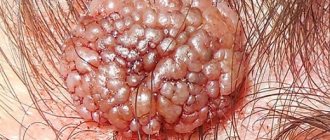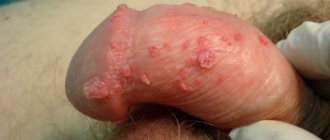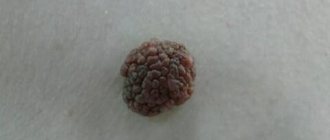Warts , or papillomas, are manifestations of the activity of the human papillomavirus (HPV) in the body. The disease has a viral basis and actively develops in cases where a person’s immunity is significantly reduced. It is considered benign and does not cause problems, provided, of course, that the locations of the warts are not subject to constant trauma. Although warts are a relatively safe and even common phenomenon, a change in their size or shape, the manifestation of signs of inflammation and, especially, darkening, should be a reason to pay close attention.
Possible reasons for color change to black
When diagnosing the condition of the growth, the doctor will take into account the person’s age. Warts are formed due to the presence of the human papillomavirus (HPV) in the body. They do not bother, do not hurt and do not pose any danger. They appear anywhere – on the arms, legs, back, face, chest, abdomen, fingers, tongue (condylomas).
Plantar growths on the feet are common, causing discomfort to the owner.
The element may darken due to disturbances in the body or for natural reasons.
- Dying followed by falling away. Occurs when a person treats the growth with means to eliminate the formation or as a natural process.
- Taking medications. Treatment of diseases includes taking medications, including antibiotics, which affect the wart and cause it to turn black.
- Infection. It occurs due to mechanical damage and may be accompanied by itching, bloody or purulent discharge, and pain. The inflammatory process in condyloma is dangerous; the symptoms should alert you and give rise to a visit to the doctor.
- Chronic disease in the acute stage.
Often a wart begins to turn black after an injury if it is located in an unfavorable place where it is constantly exposed to friction. In such a situation, you need to immediately make an appointment with a dermatologist.
Is it dangerous
Darkening occurs partially or completely.
There is no need to worry if a black spot appears on the formation - this is what the root of the growth looks like.
If there are more than two such spots, it’s time to go to the hospital to consult a doctor. Dark spots may be damaged capillaries, and spots may be dried blood.
Unpleasant symptoms will be alarming:
- bleeding;
- pain when touched;
- active growth;
- compaction of formation;
- itching;
- redness of the skin around the affected area.
If the wart becomes very black, but does not fall off, or its carrier has not reached retirement age, you should consult a doctor. If over time the growth begins to fall off, it is better to save it and send it for analysis to oncology to ensure that the growth is benign.
The need to remove the formation is determined by a dermatologist or oncologist. Drug treatment can also help eliminate papilloma; sometimes urgent surgical intervention is necessary. It all depends on the cause of the growth. It may not be a wart or condyloma, but a malignant mole.
Symptoms
Changing the color shade of a wart has its own characteristic features. For example, the growth may not completely change color, but form only one black dot in the center. Often several such points appear, which are a consequence of blockage of the capillaries of the wart.
If black spots form on the plantar growth, this may indicate that dirt or a subcutaneous infection has entered it, which can only be eliminated with the help of medications. If warts with blackheads are not treated in a timely manner, the symptoms of papillomavirus may spread from the plantar area to other areas.
Another characteristic feature of the blackening of a new growth is the change in the color of its roots to a corresponding shade. Initially, the roots of the growth are flesh-colored, similar to the shade of the skin.
Over time, under the influence of provoking factors, the root, filled with blood vessels, darkens. If black roots stick out from a wart that has already fallen off, this does not indicate a complete cure of the pathology, because in this case relapses are possible.
On this topic
In most cases, warts with black stems fall off, the roots turn black and die, and the blood in them dries up, creating blood clots.
The latter can have a negative impact on health. It is for this reason that immediately after a growth with a black root falls off, it is recommended to visit a doctor as soon as possible, who will prescribe the most effective therapy.
Neoplasms of this type, which are black or dark brown in color, often form in older people. In this case, there is no health threat as such.
When growths form in young people, it is better to resort to surgical intervention to remove them, because the presence of large black warts often causes complexes in a person.
Methods for removing black warts
The patient can decide to remove it independently (if the wart is in a visible place - a cosmetic defect) or on the advice of a doctor if there is a risk of transformation into a malignant formation and tumor development. Remove under medical supervision, in a medical facility or at home. The first option is safer: it is prohibited to squeeze out and destroy even benign formations on your own. Self-medication is a method of incomplete removal of the growth and aggravation of the situation.
In the hospital
A popular but outdated method of getting rid of warts is surgery. The disadvantage is bleeding that occurs during the procedure and the likelihood of relapse in case of incomplete root removal.
There are alternative methods.
- Exposure to chemicals, acid: treating the area with ointments and preparations to destroy formations.
- Laser removal recommended in most clinics and hospitals. The papilloma is completely removed along with the root. Anesthetics, which the doctor pre-treats the skin with, ensure the absence of pain. After the disposal method, you will need to take care of the treated area; a small burn remains on it.
- Cryotherapy. It involves exposure to low temperatures by treating the formation with liquid nitrogen. Cryodestruction promotes the death of the neoplasm.
- Radio wave removal. It is considered effective in the absence of contraindications.
The advantage of getting rid of a wart in a hospital is the control of specialists who will monitor the procedure and advise proper skin care after the destruction is completed.
After the manipulations, therapy is prescribed - taking drugs that increase immunity. Black warts on the body are a consequence of the activity of the papilloma virus. Immunomodulatory drugs are prescribed.
At home
Need advice from an experienced doctor?
Get a doctor's consultation online. Ask your question right now.
Ask a free question
Traditional methods involve removing warts on the body using compresses and lotions. Before use, be sure to check with your doctor whether the method will be effective. The solution should not harm the skin: worsen the condition, leave burns or cause other consequences. A popular plant that helps eliminate growths is celandine. Its action is to cauterize the area with the juice contained in the stems. You need to act carefully, the juice burns healthy skin. The liquid should be freshly squeezed out: before processing, you need to cut off a piece of the stem and lightly press on it, and immediately apply the resulting juice to the formation. Such actions will lead to its complete blackening and subsequent death. Using garlic juice or treating with vinegar is effective.
At home, you can use pharmaceutical preparations with a cauterizing effect - SuperChistotel, Ferezol, Kryopharma. These drugs are prescribed by doctors; before using them, you should familiarize yourself with the side effects and contraindications and study the instructions. After completing therapy, the papilloma will begin to shrink, dry out and fall off.
First aid for damaged growth
To provide first aid in case of rupture or incomplete removal of a wart with clear clinical symptoms, it is necessary to perform a number of manipulations:
- treat the affected area with local antiseptics (chlorhexidine, miramistin) or hydrogen peroxide. If there is bleeding, moisten a cotton swab and press it firmly to the wound; if necessary, change the cotton swab several times until the bleeding has completely stopped;
- in the absence of antiseptics, dilute one to one with water and alcohol. Pure alcohol is an aggressive environment for warts; the cauterizing effect in this case is undesirable;
- after bleeding has stopped, it is necessary to protect the wound surface from external influences by gluing a bactericidal, non-fabric plaster or applying a cotton-gauze bandage.
When to see a doctor
Doubtful warts require consultation with a doctor. If until a certain time it did not bother, did not cause inconvenience and did not change color, but extraneous symptoms appeared, you should definitely contact a dermatologist.
If the papilloma does not change in size, there is only one black dot on it - the root, there is no need to worry. When the number of spots is 2 or more, you need to visit a dermatologist.
If blackening is accompanied by unpleasant symptoms, you will need to consult an oncologist. Timely detection of the problem and getting rid of it will allow you not to worry about cancer.
Treatment
Methods for removing warts:
- exfoliation with acids;
- cauterization with liquid nitrogen;
- laser exposure;
- folk remedies.
Each of these methods has its own advantages and disadvantages. Home treatment with folk remedies allows you to use inexpensive drugs and products. This is a gentle option, but less effective and fast.
The laser acts precisely on the required area, the procedure is carried out by a professional doctor or cosmetologist and has no contraindications. However, it is characterized by pain, high cost and the presence of a recovery period when it is necessary to protect the treated area from the influence of sunlight.
Possible complications and precautions
Complications can arise if a person does not respond to alarming symptoms or decides to eliminate the problem without the help of doctors. Among the likely consequences:
- the appearance of new growths;
- inflammatory process in adjacent tissues.
To protect your skin and body from tumors and the HPV virus, you should follow the rules of personal hygiene, avoid tight underwear and other chafing clothing, and use protection during sexual intercourse. You need to take care of your immune system, lead a healthy lifestyle, eat right and follow a sleep schedule, avoid stress and get good rest.
A wart that has darkened is a signal of ongoing diseases in the body or the result of their treatment, sometimes it indicates problems with the immune system and the beginning of degeneration into a malignant formation. The appearance of blackheads is not a reason to panic. Contact a dermatologist or oncologist for advice and diagnosis. The doctor will be able to determine whether the growth needs to be removed.
The article has been reviewed by the site editors
Diagnostics
To determine the most effective treatment and identify the cause of the blackening of the wart, you need to visit a specialist. Based on the area of the body where the growth occurs, it depends which doctor a person should see:
- in the eye - see an ophthalmologist;
- in the area of the mammary glands - to a mammologist;
- in the anus - to a proctologist;
- in the genital area - to a gynecologist (women) or urologist (men);
- on the mucous membranes of the oral cavity - see a dentist or otolaryngologist;
- in other areas of the body - see a dermatologist.
On this topic
After conducting a visual examination of the skin where the growth is located, the doctor will prescribe certain diagnostic measures that will help determine the percentage of danger of changes in the tumor. As a rule, the following laboratory tests are carried out:
- Polymerase chain reaction analysis In this case, it is possible to determine the structure of the DNA of the virus, as well as the type of darkened growth.
- Biopsy method . The specialist takes a sample of material from the surface of the blackened wart. Using histological examination, you can determine how benign a wart is.
Based on the results of the studies, the doctor prescribes the necessary treatment.











